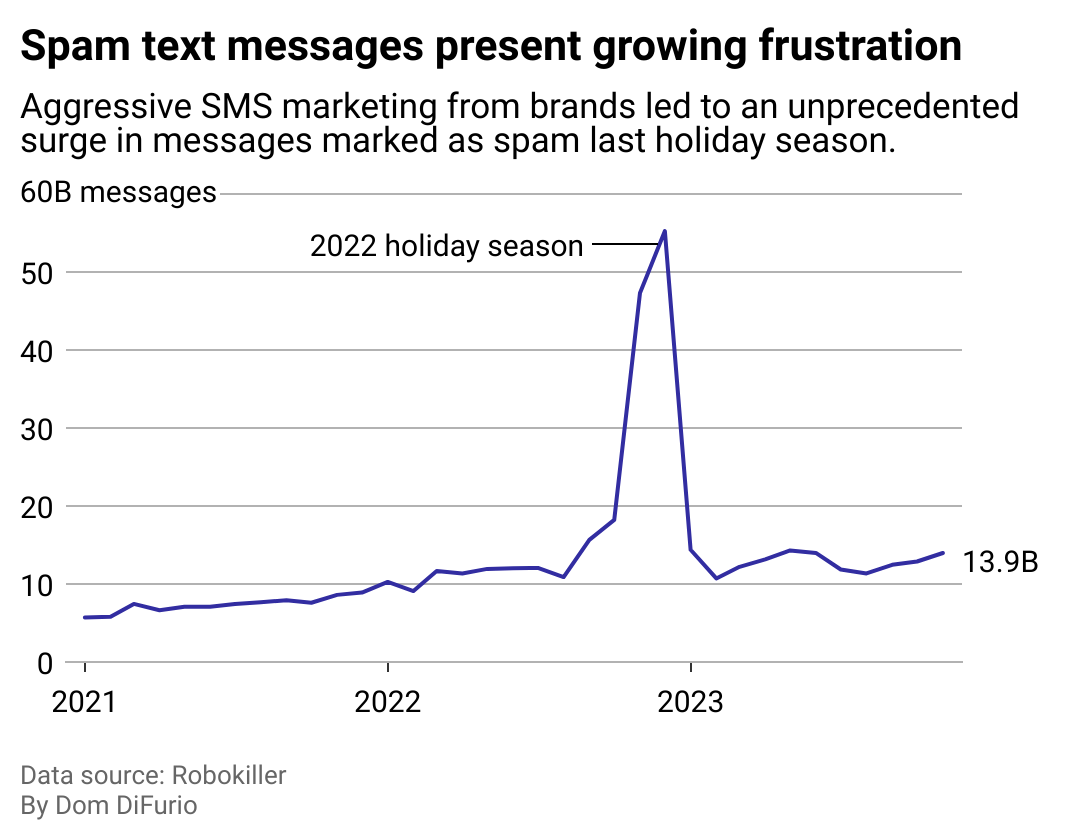This holiday spam text season came with less aggressive promotion from brands
Canva
This holiday spam text season came with less aggressive promotion from brands
A woman checking her phone while a little girl does crafts next to her.
Last holiday season, phones were vibrating off the table with incoming text messages from brands and often scammers too.
Technology to block spam calls and texts, which Americans used to report the messages hitting their SMS inboxes at record rates, highlighted the aggressiveness with which marketers targeted Americans over the holidays in 2022.
However, this November, a similar pattern failed to materialize, suggesting a shift in the way brands and consumers are treating text message communications, according to a Spokeo analysis of the most recently available spam text message data from one of those spam-filtering platforms, Robokiller. (Note: Spokeo and Robokiller are not affiliated with each other.)
Spam texts have overtaken robocalls, calls delivering prerecorded messages via auto-dialing software, as the leading source of phone spam in recent years, according to data shared by the spam-filtering app. That’s happening as the Federal Communications Commission has made efforts to crack down on annoying robocalls by updating requirements for caller ID authentication standards for voice call providers.
Pew Research Center found that most Americans won’t answer a phone call from a caller ID they don’t recognize, shutting off a valuable avenue of outreach for marketers. That reticence also presented a problem for federal efforts to track the spread of COVID-19 in 2020, highlighting the importance of finding a way to keep lines of emergency communication open.
But thanks to new tech platforms, sending automated text messages or phone calls, also called robocalls, are cheap and effective ways to get directly in front of consumers today—whether the intentions are good or fraudulent.
![]()

Spokeo
Spam deluge fails to materialize this holiday season
A line chart showing the growth of spam text messages received by American users of the RoboKiller app. Total messages receive have grown from 5 billion per month in early 2021 to 14 billion in November 2023. The number of messages spike 5 times their typical rate last holiday season during November and December due to aggressive brand marketing. The trend has failed to materialize this year.
The reduction in spam text messages flagged this year is because of companies “striking a balance between promoting their products and respecting customer opt-in preferences,” Robokiller said in a December 2023 release.
Last year, the company discovered that brands leaning heavily into a new channel for promotions and marketing were responsible for roughly 70% of spam, which consisted of robotexts. But consumers found them spammy enough to report.
Potentially fraudulent scams accounted for the other 30% of last year’s strange spike. Popular forms of text message scams include messages posing as a delivery update claiming a package can’t be shipped properly unless you take action; fake offers for “free” gifts, like a phone bill paid in full, along with a link to redeem; and phony bank fraud-prevention alerts.
As of this year, surveys suggest most shoppers in the U.S. and Canada have encountered requests from e-commerce retailers to send them texts for discounts—a promotional method that gained steam in the wake of the COVID-19 pandemic.
A 2023 survey from SMS marketing firm Attentive found that most respondents, representing over 9 in 10 shoppers (93%) across the U.S. and Canada, were interested in or had already opted into receiving text messages from brands. Yet another survey attempting to drill into how consumers felt about getting texts from companies found that over 3 in 4 respondents (78%) found them annoying.
Fears of a looming recession marred the 2022 holiday season. Consumers were running low on the extra cash put in their wallets by government bailouts during the pandemic, and rising interest rates were making credit card debt more onerous.
Bucking economists’ continued concerns about a potential pullback in consumer spending, Black Friday sales this year grew once again, with deal-savvy shoppers spending 7.5% more on online purchases, according to an Adobe Analytics report.
The scams and spam may be less frequent this year, but they’re still out there, and consumers should not let down their guards.
Canva
How to deal with spam texts
A woman looking at a cell phone.
You can report to the Federal Trade Commission if you think you’ve been targeted by a fraudulent scam or lost money as a result. The agency will then share the information with law enforcement.
To limit phone spam, it’s also a good idea to add your phone number to the National Do Not Call Registry. Telemarketers acting lawfully are required to avoid contacting consumers on the list. Of course, not all the people reaching you with unsolicited messages are acting lawfully. And the Do Not Call Registry also won’t protect you from the increasing number of spam text messages flying around.
On iPhones, Apple has included a “Block and report spam” option for incoming text messages from phone numbers not already saved in your contacts. Android devices’ phone application settings allow users to toggle on spam call filtering. One-off blocking is also an option when long-pressing a call log item in the phone app or a text message in the SMS app on either device.
Voice and text providers like AT&T, Verizon, and T-Mobile have their own spam-filtering services available to their customers. For AT&T, customers can take advantage of its ActiveArmor app; Verizon has its Call Filter app; and T-Mobile offers Scam Shield. There are also third-party app companies that provide spam-filtering services, like Robokiller and Truecaller.
Story editing by Jeff Inglis. Copy editing by Paris Close. Photo selection by Lacy Kerrick.
This story originally appeared on Spokeo and was produced and
distributed in partnership with Stacker Studio.

